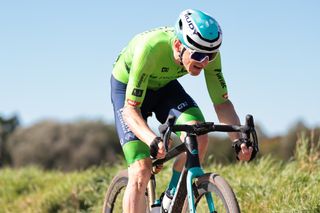Part of the Grand Tour treble club – a stage winner in each of the Giro, Tour de France and Vuelta – Matej Mohorič is known for his daredevil descending and long-range attacks. In 2023, he became gravel world champion, but his preparations for defending his title this year hit an obstacle when he injured himself training for the Sea Otter Europa gravel race. He took to the startline in Leuven, Belgium, in October, but finished seventh.
Here’s a look at the training he undertook in the lead-up to race day…
Matej Mohorič’s pre Gravel Worlds training diary
- The week: 30 Sept – 6 Oct
- Location: Monaco and Belgium
- Training for: Gravel World Championships (6 October)
- Total hours: 17
Monday: Over-unders session
The day before was a five-hour endurance ride. On Monday I wanted to get my engine running, as I hadn’t raced for two weeks. During this three-hour ride, I spent 20 minutes at or above my VO2 max, building up some lactate and flushing it away to build my lactate tolerance. I fluctuated between 20 seconds on, 40 seconds off, 30/30 and 40/20.
Total riding: 3hr
Tuesday: Rest day
A day off with my two kids. I generally eat the same quantity of food at meals on rest days, and only up my intake of nutrients when riding.
The latest race content, interviews, features, reviews and expert buying guides, direct to your inbox!
Total riding: 0hr
Wednesday: Indoor heat training
Indoor training makes a huge positive difference to me, and I strive to do it three times a week, riding for at least one hour each time in a slightly overheated state. I’ll typically ride with the fans on and then turn them right down, hanging in there as long as I can. This session was an endurance ride with a big calorie deficit [having eaten little beforehand] at Zone 2 and 3 for three hours, occasionally touching Zone 4.
Total riding: 3hr
Thursday: Travel day
I travelled to Belgium in the afternoon [ahead of the Gravel Worlds], so I just did one hour easy on the indoor trainer without any intervals.
Total riding: 1hr
Friday: Race recce
We rode most of the route of the Gravel Worlds. As usual, this course recce was ridden at a good pace with some relaxed moments, while paying attention to the most important sections to look for the best line, which is especially important in gravel racing. I put in some efforts on this ride, as I could feel my body was recovering well, and I race better with a bit of fatigue in my legs, as opposed to being completely fresh.
Total riding: 3hr 30m
Saturday: Pre-race ride
We rode the first part of the course that we hadn’t recce’d on Friday to make sure that we had seen the entire route. It’s not a course that fans of Unbound will like, and 50% of it is unpaved. Interestingly, the trickiest sections are on the road; I knew we’d be eating, drinking and recovering on the gravel sections.
Total riding: 1hr 45m
Sunday Race day: Gravel World Champs
I held a good position from the start and took care to save as much energy as possible in the first two hours. I brought back Mathieu van der Poel’s first two attacks, but I missed Florian Vermeersch’s attack, meaning I was in a small group fighting for the last medal. I went all-in during the sprint and attacked early, but I ended up with seventh place. Considering my run-in to the race it gives me confidence for the final races of the season.
Total riding: 4hr 45min
Training Q&A with Matej Mohorič
Rider profile

(Image credit: SWPix)
Age: 30
Raised: Kranj, Slovenia
Lives: Monaco
Height: 6ft 1in
Rides for: Bahrain Victorious
Best results: 1st – Milan-San Remo (2022); 3x stages – Tour de France (2021, 2023)
How did your injury affect your build-up to the Gravel Worlds?
I crashed on the easy part of the recon for Sea Otter Europa and hurt the outside of my palm and fingers, cutting the skin pretty badly and exposing the tendon. For the first week, I had no strength in my hand and couldn’t grip the handlebar, hence why I missed the Road Worlds. I forced myself onto the home trainer and did some heat training to ensure that I lost as little condition as possible.
How do you train for gravel racing?
Smooth gradient gravel climbs are almost non-existent. The alternative – doing reps on asphalt on a gravel bike – is unnecessary when I’ve got a road bike. So curiously I train very little on my gravel bike.
Does your off-road background help your gravel skills?
I’ve never raced mountain bike, but I grew up as a kid riding trails, and it was at those ages where I learned the subconscious parts of being off-road.
What might surprise people about your training?
That altitude doesn’t work for me. On previous camps, the first few days when everyone’s got a high heart rate, mine is the same as at sea level, and when most riders produce way more lactate at 2,000m, mine barely changes. My body doesn’t get stressed at altitude.

